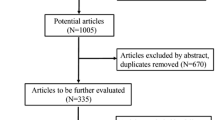Abstract
Purpose
Endoscopic thoracic sympathectomy/sympathotomy for the treatment of palmar hyperhidrosis is generally performed by either cutting or clamping the sympathetic chain. However, it remains unclear as to which of these methods is more effective and has fewer side effects. This study was conducted to compare the effects of sympathotomy by cutting or clamping at T3 on two outcomes—postoperative palmar sweating and compensatory sweating; it also evaluated postoperative patient satisfaction.
Methods
The participants were among 289 patients who underwent bilateral sympathotomy at T3 for palmar hyperhidrosis. These patients were sent questionnaires by mail to assess their self-reported degree of postoperative palmar sweating and compensatory sweating, as well as their level of satisfaction. Of the 92 patients who responded to the questionnaire, 54 had undergone sympathotomy by cutting (cutting group) and 38 by clamping (clamping group).
Results
The degree of postoperative palmar sweating was significantly lower in the cutting group than in the clamping group. However, compensatory sweating was significantly more severe in the cutting group than in the clamping group. No significant difference was observed in the degree of patient satisfaction between the groups.
Conclusions
Sympathotomy by clamping at T3 was less effective in reducing the primary symptom of postoperative palmar sweating, but induced less compensatory sweating than did sympathotomy by cutting at T3. However, both methods were similar with regard to patient satisfaction. The degree of postoperative palmar sweating and the severity of compensatory sweating were inversely correlated with the degree of patient satisfaction.



Similar content being viewed by others
References
Sugimura H, Spratt EH, Compeau CG, Kattail D, Shargall Y (2009) Thoracoscopic sympathetic clipping for hyperhidrosis: long-term results and reversibility. J Thorac Cardiovasc Surg 137:1370–1377
Rodríguez PM, Freixinet JL, Hussein M, Valencia JM, Gil RM, Herrero J, Caballero-Hidalgo A (2008) Side effects, complications and outcome of thoracoscopic sympathectomy for palmar and axillary hyperhidrosis in 406 patients. Eur J Cardiothorac Surg 34:514–519
Licht PB, Pilegaard HK (2004) Severity of compensatory sweating after thoracoscopic sympathectomy. Ann Thorac Surg 78:427–431
Miller DL, Bryant AS, Force SD, Miller JI Jr (2009) Effect of sympathectomy level on the incidence of compensatory hyperhidrosis after sympathectomy for palmar hyperhidrosis. J Thorac Cardiovasc Surg 138:581–585
Li X, Tu YR, Lin M, Lai FC, Chen JF, Dai ZJ (2008) Endoscopic thoracic sympathectomy for palmar hyperhidrosis: a randomized control trial comparing T3 and T2–4 ablation. Ann Thorac Surg 85:1747–1751
Yanagihara TK, Ibrahimiye A, Harris C, Hirsch J, Gorenstein LA (2010) Analysis of clamping versus cutting of T3 sympathetic nerve for severe palmar hyperhidrosis. J Thorac Cardiovasc Surg 140:984–989
Cerfolio RJ, De Campos JR, Bryant AS, Connery CP, Miller DL, DeCamp MM, McKenna RJ, Krasna MJ (2011) The Society of Thoracic Surgeons expert consensus for the surgical treatment of hyperhidrosis. Ann Thorac Surg 91:1642–1648
Deng B, Tan QY, Jiang YG, Zhao YP, Zhou JH, Ma Z, Wang RW (2011) Optimization of sympathectomy to treat palmar hyperhidrosis: the systematic review and meta-analysis of studies published during the past decade. Surg Endosc 25:1893–1901
Findikcioglu A, Kilic D, Hatipoglu A (2014) Is clipping superior to cauterization in the treatment of palmar hyperhidrosis? Thorac Cardiovasc Surg 62:445–449
Fibla JJ, Molins L, Mier JM, Vidal G (2009) Effectiveness of sympathetic block by clipping in the treatment of hyperhidrosis and facial blushing. Interact CardioVasc Thorac Surg 9:970–972
Yano M, Kiriyama M, Fukai I, Sasaki H, Kobayashi Y, Mizuno K, Haneda H, Suzuki E, Endo K, Fujii Y (2005) Endoscopic thoracic sympathectomy for palmar hyperhidrosis: efficacy of T2 and T3 ganglion resection. Surgery 138:40–45
Atkinson JL, Fode-Thomas NC, Fealey RD, Eisenach JH, Goerss SJ (2011) Endoscopic transthoracic limited sympathotomy for palmar-plantar hyperhidrosis: outcomes and complications during a 10-year period. Mayo Clin Proc 86:721–729
Katara AN, Domino JP, Cheah WK, So JB, Ning C, Lomanto D (2007) Comparing T2 and T2–T3 ablation in thoracoscopic sympathectomy for palmar hyperhidrosis: a randomized control trial. Surg Endosc 21:1768–1771
De Campos JR, Kauffman P, Werebe EC, Andrade Filho LO, Kusniek S, Wolosker N, Jatene FB (2003) Quality of life, before and after thoracic sympathectomy: report on 378 operated patients. Ann Thorac Surg 76:886–891
Chang YT, Li HP, Lee JY, Lin PJ, Lin CC, Kao EL, Chou SH, Huang MF (2007) Treatment of palmar hyperhidrosis: T4 level compared with T3 and T2. Ann Surg 246:330–336
Aoki H, Sakai T, Murata H, Sumikawa K (2014) Extent of sympathectomy affects postoperative compensatory sweating and satisfaction in patients with palmar hyperhidrosis. J Anesth 28:210–213
Baumgartner FJ, Reyes M, Sarkisyan GG, Iglesias A, Reyes E (2011) Thoracoscopic sympathicotomy for disabling palmar hyperhidrosis: a prospective randomized comparison between two levels. Ann Thorac Surg 92:2015–2019
Dumont P, Denoyer A, Robin P (2004) Long-term results of thoracoscopic sympathectomy for hyperhidrosis. Ann Thorac Surg 78:1801–1807
Conflict of interest
None.
Author information
Authors and Affiliations
Corresponding author
Rights and permissions
About this article
Cite this article
Hida, K., Sakai, T., Hayashi, M. et al. Sympathotomy for palmar hyperhidrosis: the cutting versus clamping methods. Clin Auton Res 25, 271–276 (2015). https://doi.org/10.1007/s10286-015-0293-y
Received:
Accepted:
Published:
Issue Date:
DOI: https://doi.org/10.1007/s10286-015-0293-y




